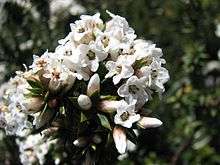Epacris breviflora
Epacris breviflora, commonly known as drumstick heath, is a plant of the heath family, Ericaceae and is endemic to the south-east of the Australian continent. It is an erect shrub with egg-shaped leaves with a sharp-pointed tip and with clusters of white flowers arranged near the end of the branches. It grows in Victoria, New South Wales and the far south-east of Queensland.
| Epacris breviflora | |
|---|---|
 | |
| Epacris breviflora growing in Baw Baw National Park | |
| Scientific classification | |
| Kingdom: | Plantae |
| Clade: | Tracheophytes |
| Clade: | Angiosperms |
| Clade: | Eudicots |
| Clade: | Asterids |
| Order: | Ericales |
| Family: | Ericaceae |
| Genus: | Epacris |
| Species: | E. breviflora |
| Binomial name | |
| Epacris breviflora | |
Description
Epacris breviflora is an erect shrub which usually grows to a height of 0.5–1.0 m (2–3 ft) and has hairy young branches. The leaves are egg-shaped 4–7.5 mm (0.2–0.3 in) long and about 1.5–3.5 mm (0.06–0.1 in) wide. The leaves have a rounded base and a sharply pointed tip. The flowers are clustered in the axils of the upper leaves. There are 10 to 23 bracts at the base of the flowers and five sepals 3–4 mm (0.1–0.2 in) long. The petals are joined to form a white, bell-shaped tube 2–3 mm (0.08–0.1 in) long with five lobes on the end, 2.5–3.5 mm (0.098–0.14 in) long. The five stamens and the single style are mostly enclosed in the petal tube. Flowering is mainly in summer but flowers are usually present throughout the year. The fruit are capsules about 2 mm (0.08 in) long.[1][2]
Taxonomy and naming
Epacris longiflora was first formally described in 1910 by Otto Stapf and the description was published in Bulletin of Miscellaneous Information.[3][4] The specific epithet (breviflora) is derived from the Latin words brevis meaning "short"[5]:708 and flos meaning "flower".[5]:338
Distribution and habitat
Drumstick heath mainly occurs along the Great Dividing Range from far south-eastern Queensland to eastern Victoria, sometimes at lower altitudes subject to cooler temperatures. It grows in swamps and other damp places.[1][2]
References
- Powell, Jocelyn M. "Epacris longiflora". Royal Botanic Garden Sydney. Retrieved 7 November 2017.
- Ohlsen, Daniel. "Epacris longiflora". Royal Botanic Gardens Victoria. Retrieved 7 November 2017.
- "Epacris breviflora". APNI. Retrieved 7 November 2017.
- Stapf, Otto (1910). "Epacris heteronema Labill. and E. dubia Lindl". Bulletin of Miscellaneous Information. 7: 216–217. Retrieved 7 November 2017.
- Brown, Roland Wilbur (1956). The Composition of Scientific Words. Washington, D.C.: Smithsonian Institution Press.